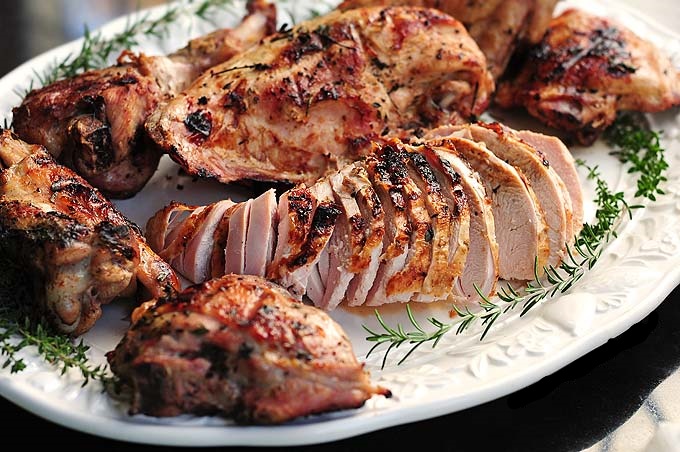(We appreciate input from author, Cat Ebeling.)
White Meat – Manna from Heaven?
White meat chicken and turkey have been the darling of health and weight loss. It has been promoted as the “low fat / low calorie” perfect protein meat.
The Department of Agriculture says an ounce of:
boneless, skinless turkey breast = 46 calories and 1 gram of fat.
boneless, skinless turkey thigh = 50 calories and 2 grams of fat.
White meat has about half the saturated fat of dark meat, it was automatically pushed as a healthier meat. Unfortunately, part of this was because of outdated health beliefs by many people.
Many U.S. doctors simply repeat the mantra of eating white or light meat instead of dark meat, because it is lower in saturated fat. However, modern research is showing some saturated fats are actually healthy for us, and not the villain they were made out to be in the 80’s and 90’s ‘fat-phobia’ period.
While white meat is a good protein delivery system, dark meat contains many more nutrients! It might be time to rethink things and take another look at the ‘dark side’.
What Makes White Meat White, And Dark Meat Dark?
Well, it has to do with how much that particular muscle was used. Chickens and turkeys, especially free-range ones, use their legs to cruise around the farmyard. They generally don’t fly or use their wings much. Because of this, their legs and thighs are dark.
Dark meat gets its color from a compound in the blood that comes from the movement of the muscles. Poultry muscles and blood contains myoglobin, (like hemoglobin, it helps transport oxygen to muscles being used). Muscles that are well-used are also full of iron to help transport oxygen. The more movement, the darker the muscle.
Dark Meat Nutrients
In a study appearing online in the European Journal of Nutrition, the New York University School of Medicine demonstrates how dark meat ultimately packs a stronger nutritional punch. Dark meat contains more selenium, zinc, vitamins A and K, riboflavin, thiamine, and B6 and B12, as well as taurine.
Taurine is such a powerful nutrient that it is considered a primary nutritional factor for longevity. This nutritional superstar also promotes insulin sensitivity, electrolyte balance, eyesight and hearing.
Age is a factor that creates an extra need for taurine, because our bodies slow down the production of it as we age. In fact, taurine, is one of the most important cognitive supplements, and can help to slow down age-related loss of memory and cognitive powers.
Taurine is also known to be an anti-inflammatory nutrient, helps in blood pressure regulation, and healthy nerve functions. NYU’s School of Medicine says taurine, significantly lowers the risk of heart disease, reducing mortality by as much as 80%, as well as protecting against diabetes and high blood pressure!
That’s Impressive!
Don’t forget the skin!
Many people pay extra just to have “boneless, skinless” chicken or turkey meat. The funny thing is that they may be leaving many nutrients behind. It is time to start using the whole bird for maximum benefits! There are a lot more edible parts to chicken or turkey than just the meat especially if you are eating free-range, organic turkeys and chickens.
The skin is full of healthy omega 3 fats which are good for:
– your skin,
– joints,
– immune system
Chicken and turkey skin contains a large amount of monounsaturated fat, the same healthy fat you find in olive oil as well as oleic acid in the skin. In fact, even Harvard’s “Ask the Expert” website said the majority of fat in chicken skin is actually heart-healthy unsaturated fats.
When we strip away the skin, we are stripping away the healthy fats (provided it is organic and free range) and collagen, as well as other benefits. Skin is almost pure collagen. Collagen, as you may already know, is one of the most important nutrients you can add to your diet. You can get plenty of collagen from the skin of chicken and turkey. In case you are curious, tendons, and ligaments pack a whopping amount of collagen too!
Our hunting-gathering ancestors naturally ate a LOT more collagen than modern humans. They generally ate the entire animal and the nutrient dense organs, skins, and cartilage.
Another delicious way to take advantage of chicken or turkey bones is to cook it slowly for 24 hours. This creates a delicious bone broth or soup base full of collagen and glucosamine. Collagen helps fight diseases like diabetes, improve your joints (drastically!), speed up healing time from athletic injuries, reduce wrinkling and sagging skin, and add strength and elasticity to hair and nails. Collagen is essential to us!
And lastly, don’t forget that delicious taste of freshly roasted crackly skin. That flavor and satisfaction go a long way towards making you feel full and satisfied.
What’s the takeaway?
Dark meat has nutritional merits above and beyond white meat. Do your best to get organic or pasture-raised poultry if you can find it. There are far less hormones, antibiotics and chemicals in it – and more nutrients. It is worth the extra money and your body will thank you!
References
1. YU Langone Medical Center / New York University School of Medicine. “Nutrient found in dark meat of poultry, some seafood, may have cardiovascular benefits.” Science Daily. 1 March 2012.
2. Feddern, Vivian, Leonor Almeida de Souza-Soares, and Xuebing Xu. “CHICKEN SKIN FAT AS RAW-MATERIAL FOR MODIFYING LIPIDS TO HIGH VALUE DIACYLGLYCEROL RICH IN PUFA.” In III Symposium on Agricultural and Agroindustrial Waste Management. 2013.
3. Harvard’s “Ask the Expert” website: https://www.hsph.harvard.edu/nutritionsource/2012/06/21/ask-the-expert-healthy-fats/

